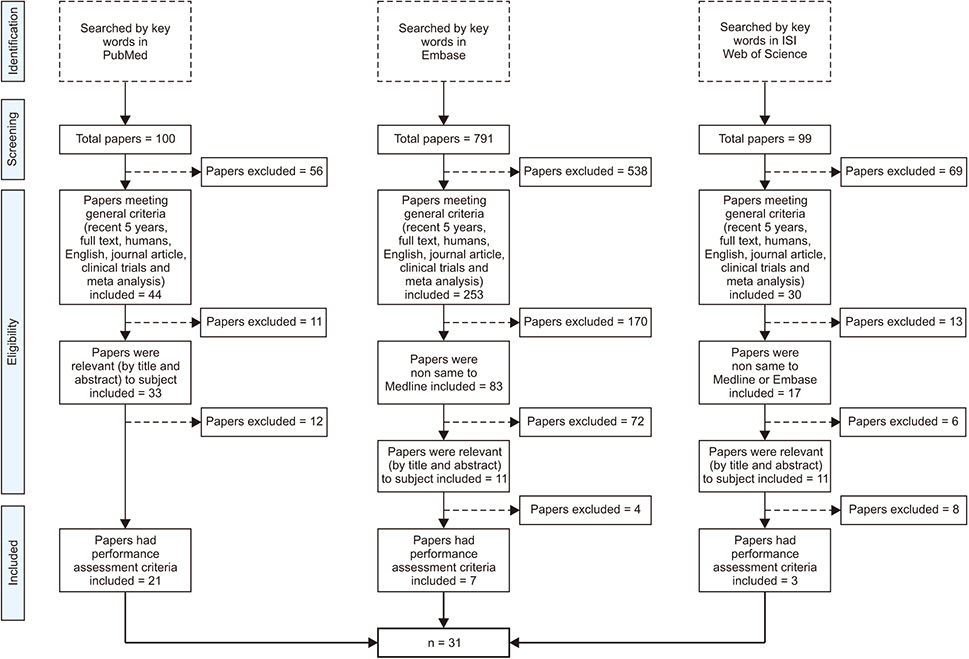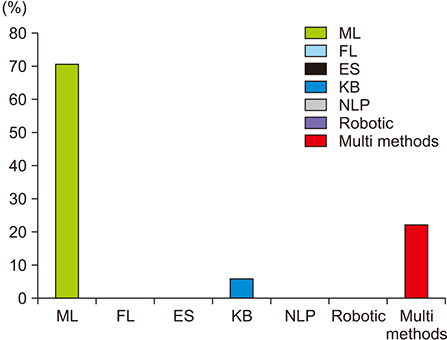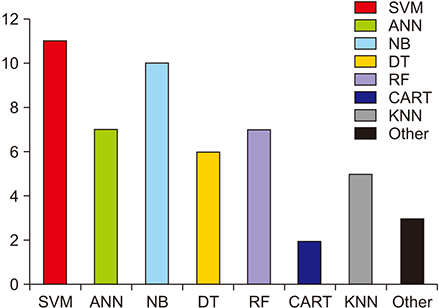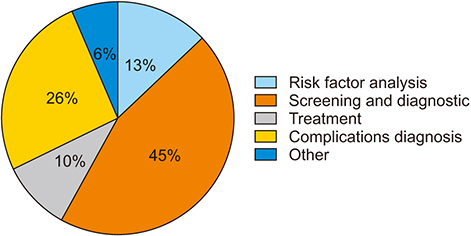Healthc Inform Res.
2019 Oct;25(4):248-261. 10.4258/hir.2019.25.4.248.
Artificial Intelligence Applications in Type 2 Diabetes Mellitus Care: Focus on Machine Learning Methods
- Affiliations
-
- 1Department of Health Information Management, School of Allied Medical Sciences, Tehran University of Medical Sciences, Tehran, Iran. sh-rniakank@sina.tums.ac.ir
- 2Department of Internal Medicine, School of Medicine, Tehran University of Medical Sciences, Tehran, Iran.
- 3Endocrinology and Metabolism Research Center, Endocrinology and Metabolism Research Institute, Tehran University of Medical Sciences, Tehran, Iran.
- 4Department of Health Information Management and Technology, School of Allied Medical Sciences, Shahid Beheshti University of Medical Sciences, Tehran, Iran.
- KMID: 2462223
- DOI: http://doi.org/10.4258/hir.2019.25.4.248
Abstract
OBJECTIVES
The incidence of type 2 diabetes mellitus has increased significantly in recent years. With the development of artificial intelligence applications in healthcare, they are used for diagnosis, therapeutic decision making, and outcome prediction, especially in type 2 diabetes mellitus. This study aimed to identify the artificial intelligence (AI) applications for type 2 diabetes mellitus care.
METHODS
This is a review conducted in 2018. We searched the PubMed, Web of Science, and Embase scientific databases, based on a combination of related mesh terms. The article selection process was based on Preferred Reporting Items for Systematic Reviews and Meta-Analyses (PRISMA). Finally, 31 articles were selected after inclusion and exclusion criteria were applied. Data gathering was done by using a data extraction form. Data were summarized and reported based on the study objectives.
RESULTS
The main applications of AI for type 2 diabetes mellitus care were screening and diagnosis in different stages. Among all of the reviewed AI methods, machine learning methods with 71% (n = 22) were the most commonly applied techniques. Many applications were in multi method forms (23%). Among the machine learning algorithms applications, support vector machine (21%) and naive Bayesian (19%) were the most commonly used methods. The most important variables that were used in the selected studies were body mass index, fasting blood sugar, blood pressure, HbA1c, triglycerides, low-density lipoprotein, high-density lipoprotein, and demographic variables.
CONCLUSIONS
It is recommended to select optimal algorithms by testing various techniques. Support vector machine and naive Bayesian might achieve better performance than other applications due to the type of variables and targets in diabetes-related outcomes classification.
Keyword
MeSH Terms
-
Artificial Intelligence*
Blood Glucose
Blood Pressure
Body Mass Index
Classification
Decision Making
Delivery of Health Care
Diabetes Mellitus
Diabetes Mellitus, Type 2*
Diagnosis
Fasting
Incidence
Lipoproteins
Machine Learning*
Mass Screening
Methods*
Support Vector Machine
Triglycerides
Blood Glucose
Lipoproteins
Triglycerides
Figure
Cited by 3 articles
-
Factors Associated with 5-Year Costs of Care among a Cohort of Alcohol Use Disorder Patients: A Bayesian Network Model
Elina Rautiainen, Olli-Pekka Ryynänen, Tiina Laatikainen, Pekka Kekolahti
Healthc Inform Res. 2020;26(2):129-145. doi: 10.4258/hir.2020.26.2.129.Drug Repositioning Using Temporal Trajectories of Accompanying Comorbidities in Diabetes Mellitus
Namgi Park, Ja Young Jeon, Eugene Jeong, Soyeon Kim, Dukyong Yoon
Endocrinol Metab. 2022;37(1):65-73. doi: 10.3803/EnM.2021.1275.Machine Learning Approach to Drug Treatment Strategy for Diabetes Care
Kazuya Fujihara, Hirohito Sone
Diabetes Metab J. 2023;47(3):325-332. doi: 10.4093/dmj.2022.0349.
Reference
-
1. Danaei G, Finucane MM, Lu Y, Singh GM, Cowan MJ, Paciorek CJ, et al. National, regional, and global trends in fasting plasma glucose and diabetes prevalence since 1980: systematic analysis of health examination surveys and epidemiological studies with 370 country-years and 2.7 million participants. Lancet. 2011; 378(9785):31–40.
Article2. World Health Organization. Global status report on noncommunicable diseases 2010. Geneva, Switzerland: World Health Organization;2011.3. World Health Organization. Definition, diagnosis and classification of diabetes mellitus and its complications: report of a WHO consultation. Part 1: Diagnosis and classification of diabetes mellitus. Geneva, Switzerland: World Health Organization;1999.4. American Diabetes Association. Diagnosis and classification of diabetes mellitus. Diabetes Care. 2014; 37 Suppl 1:S81–S90.5. World Health Organization. Global report on diabetes. Geneva, Switzerland: World Health Organization;2016.6. Robertson AR, Fernando B, Morrison Z, Kalra D, Sheikh A. Structuring and coding in health care records: a qualitative analysis using diabetes as a case study. J Innov Health Inform. 2015; 22(2):275–283.
Article7. Quinn L. Glucose monitoring in the acutely ill patient with diabetes mellitus. Crit Care Nurs Q. 1998; 21(3):85–96.8. Naqshbandi M, Harris SB, Esler JG, Antwi-Nsiah F. Global complication rates of type 2 diabetes in Indigenous peoples: A comprehensive review. Diabetes Res Clin Pract. 2008; 82(1):1–17.
Article9. Amos AF, McCarty DJ, Zimmet P. The rising global burden of diabetes and its complications: estimates and projections to the year 2010. Diabet Med. 1997; 14 Suppl 5:S1–S85.
Article10. Vashist SK. Non-invasive glucose monitoring technology in diabetes management: a review. Anal Chim Acta. 2012; 750:16–27.
Article11. Zhang P, Zhang X, Brown J, Vistisen D, Sicree R, Shaw J, et al. Global healthcare expenditure on diabetes for 2010 and 2030. Diabetes Res Clin Pract. 2010; 87(3):293–301.
Article12. International Diabetes Association. New estimates for 2012 of diabetes prevalence, mortality, and healthcare expenditures. Brussels, Belgium: International Diabetes Association;2012.13. Wild S, Roglic G, Green A, Sicree R, King H. Global prevalence of diabetes: estimates for the year 2000 and projections for 2030. Diabetes Care. 2004; 27(5):1047–1053.
Article14. Whiting DR, Guariguata L, Weil C, Shaw J. IDF diabetes atlas: global estimates of the prevalence of diabetes for 2011 and 2030. Diabetes Res Clin Pract. 2011; 94(3):311–321.
Article15. Sautin M, Suchkov S. Opportunities of predictive medicine at the treatment of diabetes mellitus complications. EPMA J. 2014; 5:Suppl 1. A73.
Article16. Roberts CK, Sindhu KK. Oxidative stress and metabolic syndrome. Life Sci. 2009; 84(21-22):705–712.
Article17. Dagliati A, Marini S, Sacchi L, Cogni G, Teliti M, Tibollo V, et al. Machine learning methods to predict diabetes complications. J Diabetes Sci Technol. 2018; 12(2):295–302.
Article18. Dargis V, Pantelejeva O, Jonushaite A, Vileikyte L, Boulton AJ. Benefits of a multidisciplinary approach in the management of recurrent diabetic foot ulceration in Lithuania: a prospective study. Diabetes Care. 1999; 22:1428–1431.
Article19. Hamet P, Tremblay J. Artificial intelligence in medicine. Metabolism. 2017; 69S:S36–S40.
Article20. Szolovits P. Artificial intelligence in medicine. Boulder(CO): Westview Press;1982.21. Ramesh AN, Kambhampati C, Monson JR, Drew PJ. Artificial intelligence in medicine. Ann R Coll Surg Engl. 2004; 86(5):334–338.
Article22. Rigla M, Garcia-Saez G, Pons B, Hernando ME. Artificial intelligence methodologies and their application to diabetes. J Diabetes Sci Technol. 2018; 12(2):303–310.
Article23. Nilsson NJ. Artificial intelligence: a new synthesis. San Francisco (CA): Morgan Kaufmann;1998.24. Contreras I, Vehi J. Artificial intelligence for diabetes management and decision support: literature review. J Med Internet Res. 2018; 20(5):e10775.
Article25. Fallah M, Niakan Kalhori SR. Systematic review of data mining applications in patient-centered mobile-based information systems. Healthc Inform Res. 2017; 23(4):262–270.
Article26. Han J, Pei J, Kamber M. Data mining: concepts and techniques. Amsterdam, Netherlands: Elsevier;2011.27. Patel VL, Shortliffe EH, Stefanelli M, Szolovits P, Berthold MR, Bellazzi R, et al. The coming of age of artificial intelligence in medicine. Artif Intell Med. 2009; 46(1):5–17.
Article28. Schwartz WB, Patil RS, Szolovits P. Artificial intelligence in medicine. N Engl J Med. 1987; 316(11):685–688.
Article29. Kavakiotis I, Tsave O, Salifoglou A, Maglaveras N, Vlahavas I, Chouvarda I. Machine learning and data mining methods in diabetes research. Comput Struct Biotechnol J. 2017; 15:104–116.
Article30. Kagawa R, Kawazoe Y, Ida Y, Shinohara E, Tanaka K, Imai T, et al. Development of type 2 diabetes mellitus phenotyping framework using expert knowledge and machine learning approach. J Diabetes Sci Technol. 2017; 11(4):791–799.
Article31. Cai J, Li C, Liu Z, Du J, Ye J, Gu Q, et al. Predicting DPP-IV inhibitors with machine learning approaches. J Comput Aided Mol Des. 2017; 31(4):393–402.
Article32. Casanova R, Saldana S, Simpson SL, Lacy ME, Subauste AR, Blackshear C, et al. Prediction of incident diabetes in the Jackson Heart Study using high-dimensional machine learning. PLoS One. 2016; 11(10):e0163942.
Article33. Anderson AE, Kerr WT, Thames A, Li T, Xiao J, Cohen MS. Electronic health record phenotyping improves detection and screening of type 2 diabetes in the general United States population: a cross-sectional, unselected, retrospective study. J Biomed Inform. 2016; 60:162–168.
Article34. Rau HH, Hsu CY, Lin YA, Atique S, Fuad A, Wei LM, et al. Development of a web-based liver cancer prediction model for type II diabetes patients by using an artificial neural network. Comput Methods Programs Biomed. 2016; 125:58–65.
Article35. Anderson JP, Parikh JR, Shenfeld DK, Ivanov V, Marks C, Church BW, et al. Reverse engineering and evaluation of prediction models for progression to type 2 diabetes: an application of machine learning using electronic health records. J Diabetes Sci Technol. 2015; 10(1):6–18.
Article36. Zhang YF, Tian Y, Zhou TS, Araki K, Li JS. Integrating HL7 RIM and ontology for unified knowledge and data representation in clinical decision support systems. Comput Methods Programs Biomed. 2016; 123:94–108.
Article37. Chen J, Tang H, Huang H, Lv L, Wang Y, Liu X, et al. Development and validation of new glomerular filtration rate predicting models for Chinese patients with type 2 diabetes. J Transl Med. 2015; 13:317.
Article38. Huang GM, Huang KY, Lee TY, Weng J. An interpretable rule-based diagnostic classification of diabetic nephropathy among type 2 diabetes patients. BMC Bioinformatics. 2015; 16 Suppl 1:S5.
Article39. Lee BJ, Kim JY. Identification of type 2 diabetes risk factors using phenotypes consisting of anthropometry and triglycerides based on machine learning. IEEE J Biomed Health Inform. 2016; 20(1):39–46.
Article40. Sudharsan B, Peeples M, Shomali M. Hypoglycemia prediction using machine learning models for patients with type 2 diabetes. J Diabetes Sci Technol. 2015; 9(1):86–90.
Article41. Luo S, Chen S, Pan L, Zhang T, Han L, Wang Y, et al. Exploring the effects of intervention for those at high risk of developing type 2 diabetes using a computer simulation. Comput Biol Med. 2014; 53:105–114.
Article42. Liaw ST, Taggart J, Yu H, de Lusignan S, Kuziemsky C, Hayen A. Integrating electronic health record information to support integrated care: practical application of ontologies to improve the accuracy of diabetes disease registers. J Biomed Inform. 2014; 52:364–372.
Article43. Chen H, Tan C, Lin Z, Wu T. The diagnostics of diabetes mellitus based on ensemble modeling and hair/urine element level analysis. Comput Biol Med. 2014; 50:70–75.
Article44. Lee BJ, Ku B, Nam J, Pham DD, Kim JY. Prediction of fasting plasma glucose status using anthropometric measures for diagnosing type 2 diabetes. IEEE J Biomed Health Inform. 2014; 18(2):555–561.
Article45. Marateb HR, Mansourian M, Faghihimani E, Amini M, Farina D. A hybrid intelligent system for diagnosing microalbuminuria in type 2 diabetes patients without having to measure urinary albumin. Comput Biol Med. 2014; 45:34–42.
Article46. Singh K, Singh VK, Agrawal NK, Gupta SK, Singh K. Association of Toll-like receptor 4 polymorphisms with diabetic foot ulcers and application of artificial neural network in DFU risk assessment in type 2 diabetes patients. Biomed Res Int. 2013; 2013:318686.
Article47. Leung RK, Wang Y, Ma RC, Luk AO, Lam V, Ng M, et al. Using a multi-staged strategy based on machine learning and mathematical modeling to predict genotype-phenotype risk patterns in diabetic kidney disease: a prospective case-control cohort analysis. BMC Nephrol. 2013; 14:162.
Article48. Wang C, Li L, Wang L, Ping Z, Flory MT, Wang G, et al. Evaluating the risk of type 2 diabetes mellitus using artificial neural network: an effective classification approach. Diabetes Res Clin Pract. 2013; 100(1):111–118.
Article49. Morteza A, Nakhjavani M, Asgarani F, Carvalho FL, Karimi R, Esteghamati A. Inconsistency in albuminuria predictors in type 2 diabetes: a comparison between neural network and conditional logistic regression. Transl Res. 2013; 161(5):397–405.
Article50. Mani S, Chen Y, Elasy T, Clayton W, Denny J. Type 2 diabetes risk forecasting from EMR data using machine learning. AMIA Annu Symp Proc. 2012; 2012:606–615.51. Chikh MA, Saidi M, Settouti N. Diagnosis of diabetes diseases using an Artificial Immune Recognition System2 (AIRS2) with fuzzy K-nearest neighbor. J Med Syst. 2012; 36(5):2721–2729.
Article52. Choubey DK, Paul S, Dhandhenia VK. Rule based diagnosis system for diabetes. An International Journal of Medical Sciences. 2017; 28(12):5196–5208.53. Zheng T, Xie W, Xu L, He X, Zhang Y, You M, et al. A machine learning-based framework to identify type 2 diabetes through electronic health records. Int J Med Inform. 2017; 97:120–127.
Article54. Agarwal V, Podchiyska T, Banda JM, Goel V, Leung TI, Minty EP, et al. Learning statistical models of phenotypes using noisy labeled training data. J Am Med Inform Assoc. 2016; 23(6):1166–1173.
Article55. Jelinek HF, Stranieri A, Yatsko A, Venkatraman S. Data analytics identify glycated haemoglobin co-markers for type 2 diabetes mellitus diagnosis. Comput Biol Med. 2016; 75:90–97.
Article56. Yu CS, Liu CS, Chen RS, Lin CW. Artificial neural networks for estimating glomerular filtration rate by urinary dipstick for type 2 diabetic patients. Biomed Eng (Singapore). 2016; 28(03):1650016.57. Luo G. Automatically explaining machine learning prediction results: a demonstration on type 2 diabetes risk prediction. Health Inf Sci Syst. 2016; 4:2.
Article58. Farran B, Channanath AM, Behbehani K, Thanaraj TA. Predictive models to assess risk of type 2 diabetes, hypertension and comorbidity: machine-learning algorithms and validation using national health data from Kuwait: a cohort study. BMJ Open. 2013; 3(5):e002457.59. Meza-Palacios R, Aguilar-Lasserre AA, Urena-Bogarín EL, Vazquez-Rodriguez CF, Posada-Gomez R, Trujillo-Mata A. Development of a fuzzy expert system for the nephropathy control assessment in patients with type 2 diabetes mellitus. Expert Syst Appl. 2017; 72:335–343.
Article60. Sayadi M, Zibaeenezhad M, Taghi Ayatollahi SM. Simple prediction of type 2 diabetes mellitus via decision tree modeling. Int Cardiovasc Res J. 2017; 11(2):71–76.61. Lee Y, Ragguett RM, Mansur RB, Boutilier JJ, Rosenblat JD, Trevizol A, et al. Applications of machine learning algorithms to predict therapeutic outcomes in depression: a meta-analysis and systematic review. J Affect Disord. 2018; 241:519–532.
Article62. Sisodia D, Sisodia DS. Prediction of diabetes using classification algorithms. Procedia Comput Sci. 2018; 132:1578–1585.
Article63. Cruz JA, Wishart DS. Applications of machine learning in cancer prediction and prognosis. Cancer Inform. 2007; 2:59–77.
Article64. Du Y, Fu Z, Calhoun VD. Classification and prediction of brain disorders using functional connectivity: promising but challenging. Front Neurosci. 2018; 12:525.
Article65. Kalhori SR, Zeng XJ. Evaluation and comparison of different machine learning methods to predict outcome of tuberculosis treatment course. J Intell Learn Syst Appl. 2013; 5:184–193.
Article66. King RD, Feng C, Sutherland A. Statlog: comparison of classification algorithms on large real-world problems. Appl Artif Intell. 1995; 9(3):289–333.
Article67. Abdar M, Kalhori SR, Sutikno T, Subroto IM, Arji G. Comparing performance of data mining algorithms in prediction heart diseases. Int J Electr Comput Eng. 2015; 5(6):1569–1576.
Article68. Kang S. Personalized prediction of drug efficacy for diabetes treatment via patient-level sequential modeling with neural networks. Artif Intell Med. 2018; 85:1–6.
Article69. Javad OM, Agboola S, Jethwani K, Zeid I, Kamarthi S. Reinforcement learning algorithm for blood glucose control in diabetic patients. In : Proceedings of ASME 2015 International Mechanical Engineering Congress and Exposition; 2015 Nov 13-19; Houston, TX.70. Aniba MR, Siguenza S, Friedrich A, Plewniak F, Poch O, Marchler-Bauer A, et al. Knowledge-based expert systems and a proof-of-concept case study for multiple sequence alignment construction and analysis. Brief Bioinform. 2009; 10(1):11–23.
Article71. Cresswell K, Cunningham-Burley S, Sheikh A. Health care robotics: qualitative exploration of key challenges and future directions. J Med Internet Res. 2018; 20(7):e10410.
Article72. Ettore E, Wyckaert E, David R, Robert P, Guerin O, Prate F. Robotics and improvement of the quality of geriatric care. Soins Gerontol. 2016; 21(121):15–17.73. Yeh CC, Spaggiari M, Tzvetanov I, Oberholzer J. Robotic pancreas transplantation in a type 1 diabetic patient with morbid obesity: a case report. Medicine (Baltimore). 2017; 96(6):e5847.74. Oberholzer J, Tzvetanov I, Mele A, Benedetti E. Laparoscopic and robotic donor pancreatectomy for living donor pancreas and pancreas-kidney transplantation. J Hepatobiliary Pancreat Sci. 2010; 17(2):97–100.
Article75. Management of type 1 diabetes in children is boosted by robots. Nurs Child Young People. 2016; 28(7):12.
- Full Text Links
- Actions
-
Cited
- CITED
-
- Close
- Share
- Similar articles
-
- Machine Learning Approach to Drug Treatment Strategy for Diabetes Care
- The Role of medical doctor in the era of artificial intelligence
- Applications of Machine Learning Using Electronic Medical Records in Spine Surgery
- The Role of a Diabetologist in the New Era of Artificial Intelligence
- Application of Machine Learning in Rhinology: A State of the Art Review





